ISBAR Handover for Osteoarthritis Patient: Assessment and Recommendations
VerifiedAdded on 2023/06/11
|6
|1534
|304
AI Summary
This article discusses the case of an 81-year-old patient suffering from osteoarthritis. The ISBAR handover process was used to assess the patient's condition, and recommendations were made to manage his symptoms and improve his quality of life. The article also highlights the importance of educating patients with poor health literacy and modifying their environment to prevent falls.
Contribute Materials
Your contribution can guide someone’s learning journey. Share your
documents today.
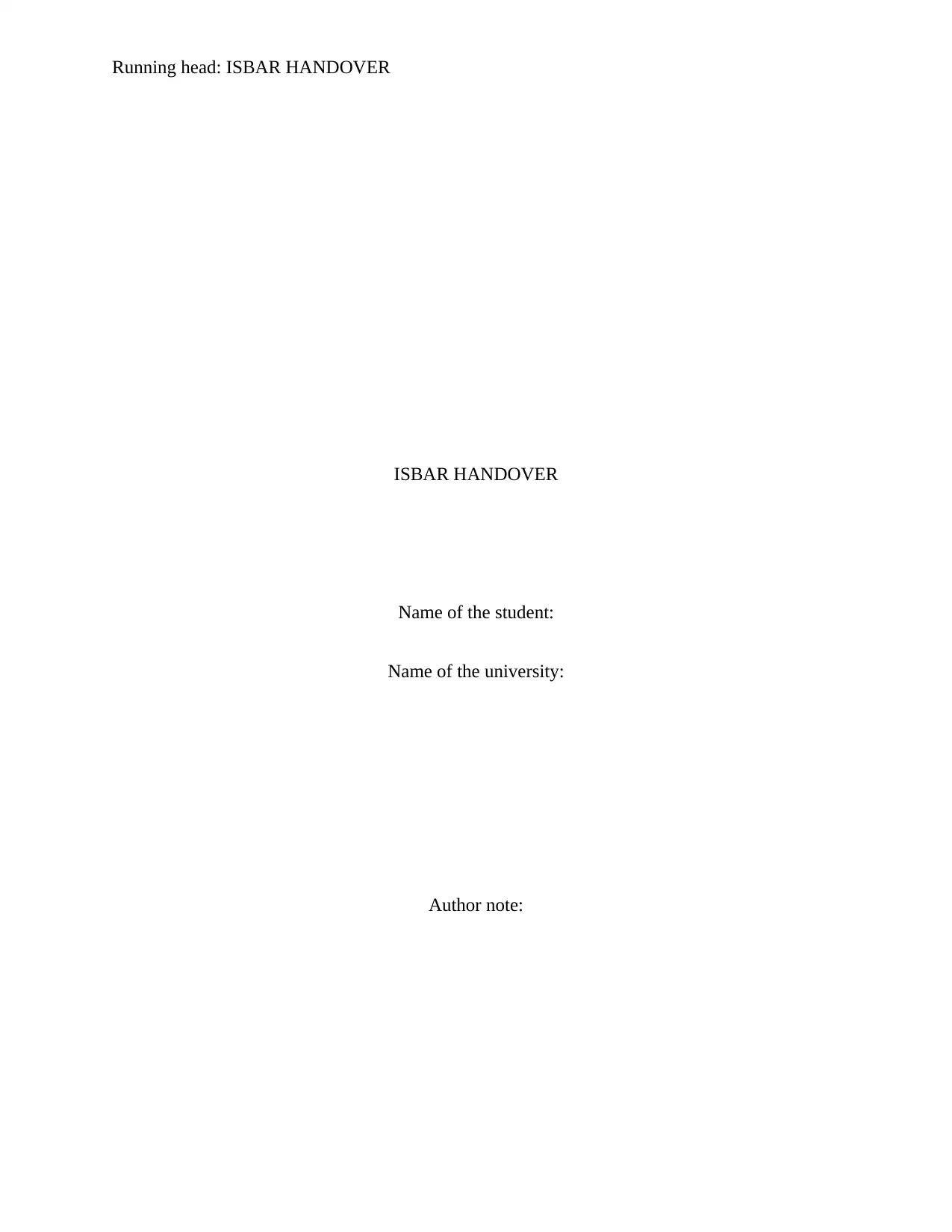
Running head: ISBAR HANDOVER
ISBAR HANDOVER
Name of the student:
Name of the university:
Author note:
ISBAR HANDOVER
Name of the student:
Name of the university:
Author note:
Secure Best Marks with AI Grader
Need help grading? Try our AI Grader for instant feedback on your assignments.
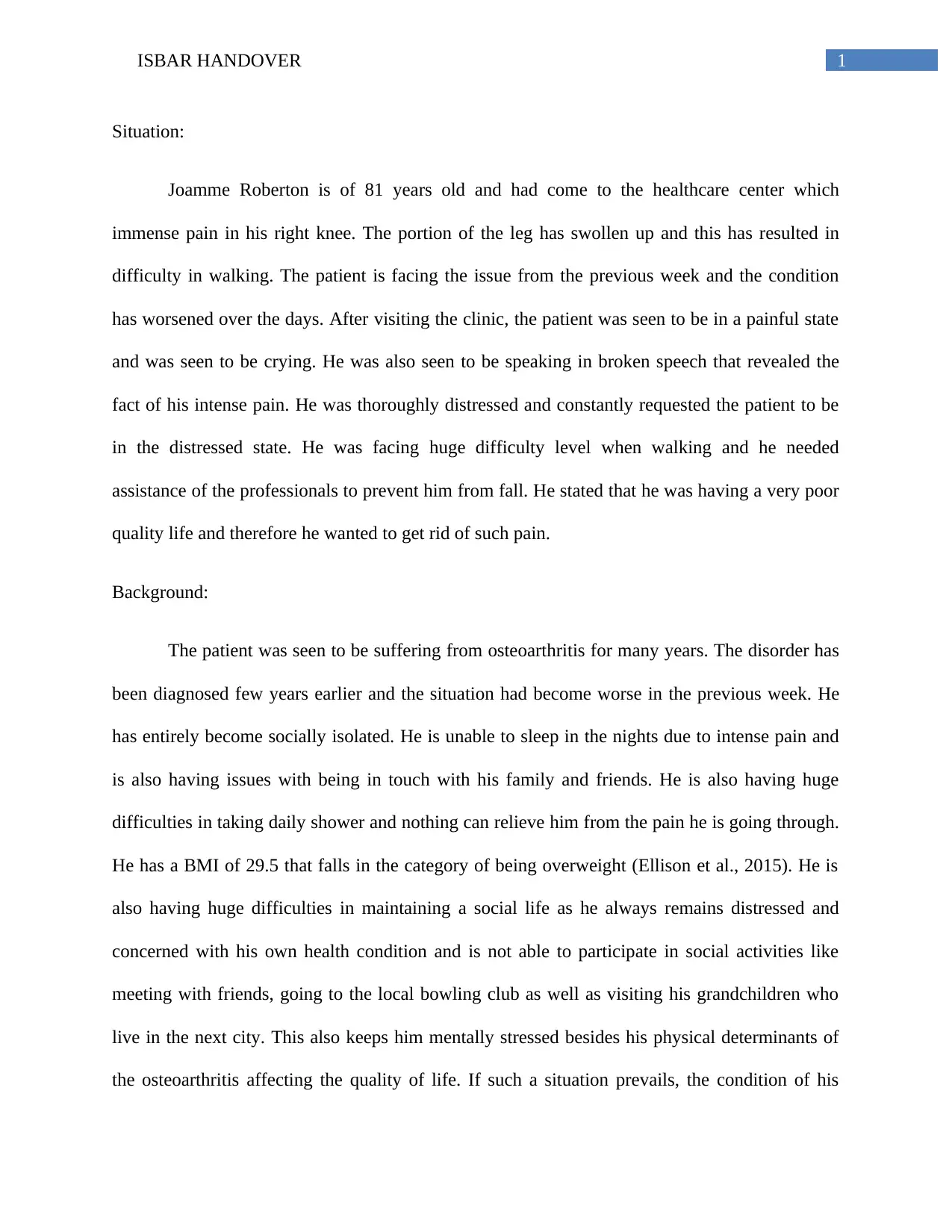
1ISBAR HANDOVER
Situation:
Joamme Roberton is of 81 years old and had come to the healthcare center which
immense pain in his right knee. The portion of the leg has swollen up and this has resulted in
difficulty in walking. The patient is facing the issue from the previous week and the condition
has worsened over the days. After visiting the clinic, the patient was seen to be in a painful state
and was seen to be crying. He was also seen to be speaking in broken speech that revealed the
fact of his intense pain. He was thoroughly distressed and constantly requested the patient to be
in the distressed state. He was facing huge difficulty level when walking and he needed
assistance of the professionals to prevent him from fall. He stated that he was having a very poor
quality life and therefore he wanted to get rid of such pain.
Background:
The patient was seen to be suffering from osteoarthritis for many years. The disorder has
been diagnosed few years earlier and the situation had become worse in the previous week. He
has entirely become socially isolated. He is unable to sleep in the nights due to intense pain and
is also having issues with being in touch with his family and friends. He is also having huge
difficulties in taking daily shower and nothing can relieve him from the pain he is going through.
He has a BMI of 29.5 that falls in the category of being overweight (Ellison et al., 2015). He is
also having huge difficulties in maintaining a social life as he always remains distressed and
concerned with his own health condition and is not able to participate in social activities like
meeting with friends, going to the local bowling club as well as visiting his grandchildren who
live in the next city. This also keeps him mentally stressed besides his physical determinants of
the osteoarthritis affecting the quality of life. If such a situation prevails, the condition of his
Situation:
Joamme Roberton is of 81 years old and had come to the healthcare center which
immense pain in his right knee. The portion of the leg has swollen up and this has resulted in
difficulty in walking. The patient is facing the issue from the previous week and the condition
has worsened over the days. After visiting the clinic, the patient was seen to be in a painful state
and was seen to be crying. He was also seen to be speaking in broken speech that revealed the
fact of his intense pain. He was thoroughly distressed and constantly requested the patient to be
in the distressed state. He was facing huge difficulty level when walking and he needed
assistance of the professionals to prevent him from fall. He stated that he was having a very poor
quality life and therefore he wanted to get rid of such pain.
Background:
The patient was seen to be suffering from osteoarthritis for many years. The disorder has
been diagnosed few years earlier and the situation had become worse in the previous week. He
has entirely become socially isolated. He is unable to sleep in the nights due to intense pain and
is also having issues with being in touch with his family and friends. He is also having huge
difficulties in taking daily shower and nothing can relieve him from the pain he is going through.
He has a BMI of 29.5 that falls in the category of being overweight (Ellison et al., 2015). He is
also having huge difficulties in maintaining a social life as he always remains distressed and
concerned with his own health condition and is not able to participate in social activities like
meeting with friends, going to the local bowling club as well as visiting his grandchildren who
live in the next city. This also keeps him mentally stressed besides his physical determinants of
the osteoarthritis affecting the quality of life. If such a situation prevails, the condition of his
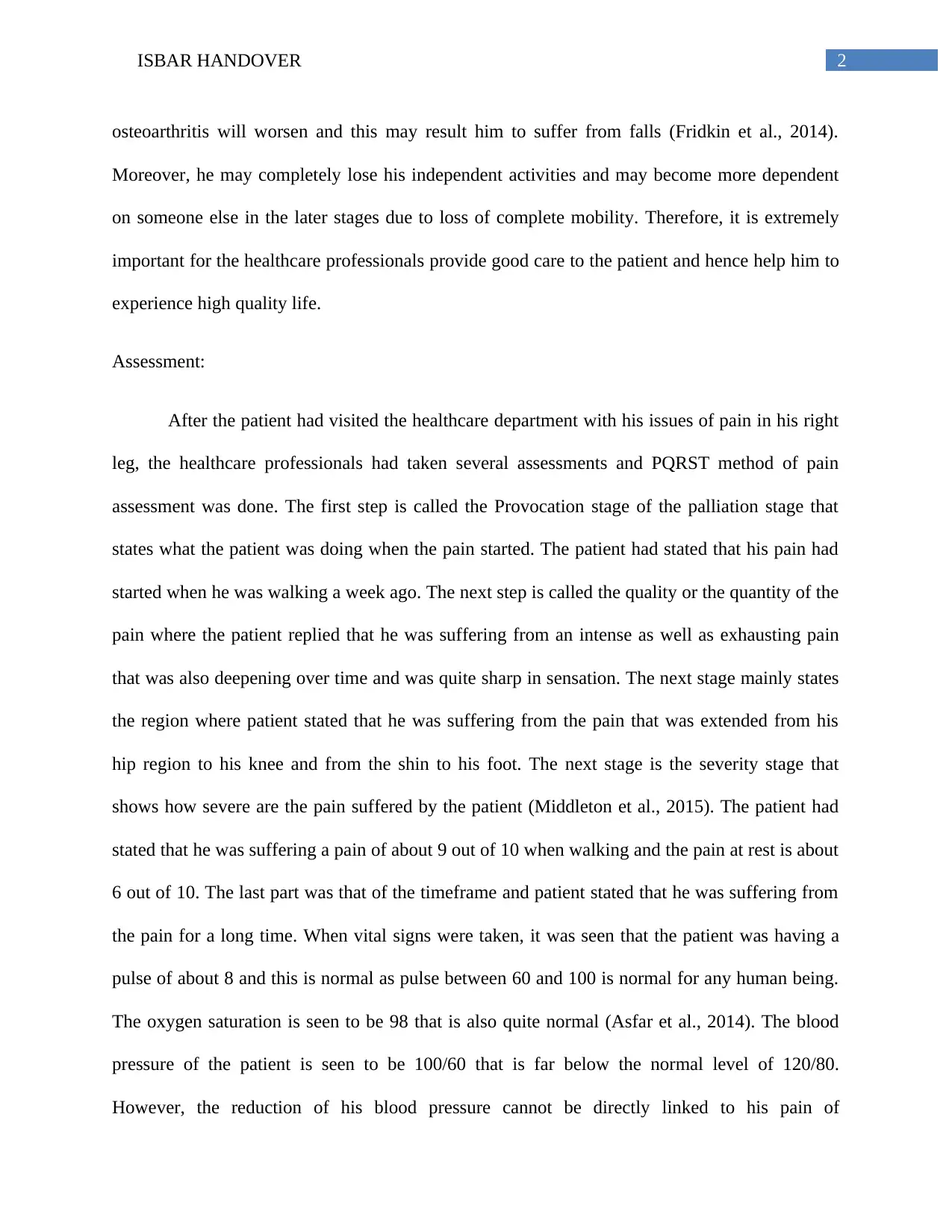
2ISBAR HANDOVER
osteoarthritis will worsen and this may result him to suffer from falls (Fridkin et al., 2014).
Moreover, he may completely lose his independent activities and may become more dependent
on someone else in the later stages due to loss of complete mobility. Therefore, it is extremely
important for the healthcare professionals provide good care to the patient and hence help him to
experience high quality life.
Assessment:
After the patient had visited the healthcare department with his issues of pain in his right
leg, the healthcare professionals had taken several assessments and PQRST method of pain
assessment was done. The first step is called the Provocation stage of the palliation stage that
states what the patient was doing when the pain started. The patient had stated that his pain had
started when he was walking a week ago. The next step is called the quality or the quantity of the
pain where the patient replied that he was suffering from an intense as well as exhausting pain
that was also deepening over time and was quite sharp in sensation. The next stage mainly states
the region where patient stated that he was suffering from the pain that was extended from his
hip region to his knee and from the shin to his foot. The next stage is the severity stage that
shows how severe are the pain suffered by the patient (Middleton et al., 2015). The patient had
stated that he was suffering a pain of about 9 out of 10 when walking and the pain at rest is about
6 out of 10. The last part was that of the timeframe and patient stated that he was suffering from
the pain for a long time. When vital signs were taken, it was seen that the patient was having a
pulse of about 8 and this is normal as pulse between 60 and 100 is normal for any human being.
The oxygen saturation is seen to be 98 that is also quite normal (Asfar et al., 2014). The blood
pressure of the patient is seen to be 100/60 that is far below the normal level of 120/80.
However, the reduction of his blood pressure cannot be directly linked to his pain of
osteoarthritis will worsen and this may result him to suffer from falls (Fridkin et al., 2014).
Moreover, he may completely lose his independent activities and may become more dependent
on someone else in the later stages due to loss of complete mobility. Therefore, it is extremely
important for the healthcare professionals provide good care to the patient and hence help him to
experience high quality life.
Assessment:
After the patient had visited the healthcare department with his issues of pain in his right
leg, the healthcare professionals had taken several assessments and PQRST method of pain
assessment was done. The first step is called the Provocation stage of the palliation stage that
states what the patient was doing when the pain started. The patient had stated that his pain had
started when he was walking a week ago. The next step is called the quality or the quantity of the
pain where the patient replied that he was suffering from an intense as well as exhausting pain
that was also deepening over time and was quite sharp in sensation. The next stage mainly states
the region where patient stated that he was suffering from the pain that was extended from his
hip region to his knee and from the shin to his foot. The next stage is the severity stage that
shows how severe are the pain suffered by the patient (Middleton et al., 2015). The patient had
stated that he was suffering a pain of about 9 out of 10 when walking and the pain at rest is about
6 out of 10. The last part was that of the timeframe and patient stated that he was suffering from
the pain for a long time. When vital signs were taken, it was seen that the patient was having a
pulse of about 8 and this is normal as pulse between 60 and 100 is normal for any human being.
The oxygen saturation is seen to be 98 that is also quite normal (Asfar et al., 2014). The blood
pressure of the patient is seen to be 100/60 that is far below the normal level of 120/80.
However, the reduction of his blood pressure cannot be directly linked to his pain of
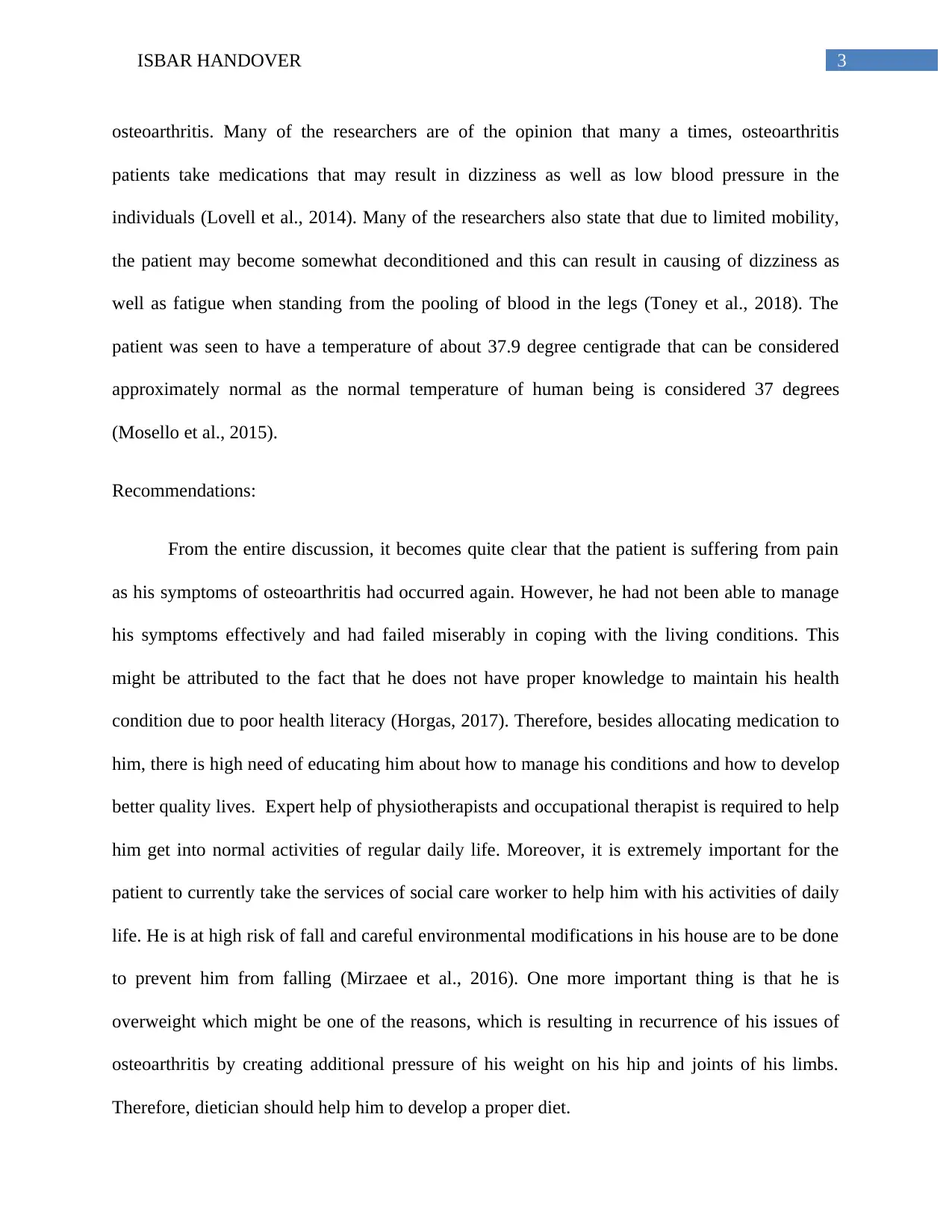
3ISBAR HANDOVER
osteoarthritis. Many of the researchers are of the opinion that many a times, osteoarthritis
patients take medications that may result in dizziness as well as low blood pressure in the
individuals (Lovell et al., 2014). Many of the researchers also state that due to limited mobility,
the patient may become somewhat deconditioned and this can result in causing of dizziness as
well as fatigue when standing from the pooling of blood in the legs (Toney et al., 2018). The
patient was seen to have a temperature of about 37.9 degree centigrade that can be considered
approximately normal as the normal temperature of human being is considered 37 degrees
(Mosello et al., 2015).
Recommendations:
From the entire discussion, it becomes quite clear that the patient is suffering from pain
as his symptoms of osteoarthritis had occurred again. However, he had not been able to manage
his symptoms effectively and had failed miserably in coping with the living conditions. This
might be attributed to the fact that he does not have proper knowledge to maintain his health
condition due to poor health literacy (Horgas, 2017). Therefore, besides allocating medication to
him, there is high need of educating him about how to manage his conditions and how to develop
better quality lives. Expert help of physiotherapists and occupational therapist is required to help
him get into normal activities of regular daily life. Moreover, it is extremely important for the
patient to currently take the services of social care worker to help him with his activities of daily
life. He is at high risk of fall and careful environmental modifications in his house are to be done
to prevent him from falling (Mirzaee et al., 2016). One more important thing is that he is
overweight which might be one of the reasons, which is resulting in recurrence of his issues of
osteoarthritis by creating additional pressure of his weight on his hip and joints of his limbs.
Therefore, dietician should help him to develop a proper diet.
osteoarthritis. Many of the researchers are of the opinion that many a times, osteoarthritis
patients take medications that may result in dizziness as well as low blood pressure in the
individuals (Lovell et al., 2014). Many of the researchers also state that due to limited mobility,
the patient may become somewhat deconditioned and this can result in causing of dizziness as
well as fatigue when standing from the pooling of blood in the legs (Toney et al., 2018). The
patient was seen to have a temperature of about 37.9 degree centigrade that can be considered
approximately normal as the normal temperature of human being is considered 37 degrees
(Mosello et al., 2015).
Recommendations:
From the entire discussion, it becomes quite clear that the patient is suffering from pain
as his symptoms of osteoarthritis had occurred again. However, he had not been able to manage
his symptoms effectively and had failed miserably in coping with the living conditions. This
might be attributed to the fact that he does not have proper knowledge to maintain his health
condition due to poor health literacy (Horgas, 2017). Therefore, besides allocating medication to
him, there is high need of educating him about how to manage his conditions and how to develop
better quality lives. Expert help of physiotherapists and occupational therapist is required to help
him get into normal activities of regular daily life. Moreover, it is extremely important for the
patient to currently take the services of social care worker to help him with his activities of daily
life. He is at high risk of fall and careful environmental modifications in his house are to be done
to prevent him from falling (Mirzaee et al., 2016). One more important thing is that he is
overweight which might be one of the reasons, which is resulting in recurrence of his issues of
osteoarthritis by creating additional pressure of his weight on his hip and joints of his limbs.
Therefore, dietician should help him to develop a proper diet.
Secure Best Marks with AI Grader
Need help grading? Try our AI Grader for instant feedback on your assignments.
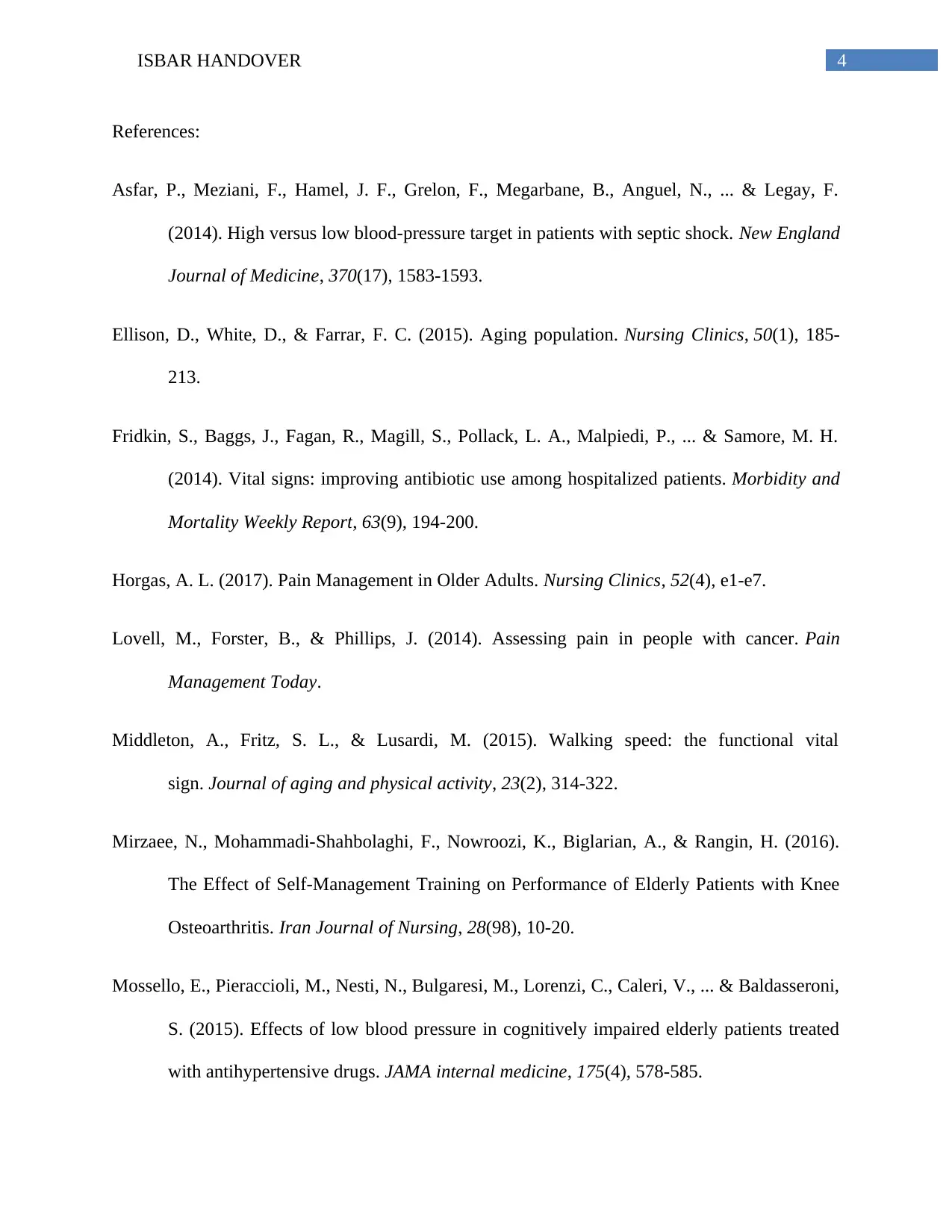
4ISBAR HANDOVER
References:
Asfar, P., Meziani, F., Hamel, J. F., Grelon, F., Megarbane, B., Anguel, N., ... & Legay, F.
(2014). High versus low blood-pressure target in patients with septic shock. New England
Journal of Medicine, 370(17), 1583-1593.
Ellison, D., White, D., & Farrar, F. C. (2015). Aging population. Nursing Clinics, 50(1), 185-
213.
Fridkin, S., Baggs, J., Fagan, R., Magill, S., Pollack, L. A., Malpiedi, P., ... & Samore, M. H.
(2014). Vital signs: improving antibiotic use among hospitalized patients. Morbidity and
Mortality Weekly Report, 63(9), 194-200.
Horgas, A. L. (2017). Pain Management in Older Adults. Nursing Clinics, 52(4), e1-e7.
Lovell, M., Forster, B., & Phillips, J. (2014). Assessing pain in people with cancer. Pain
Management Today.
Middleton, A., Fritz, S. L., & Lusardi, M. (2015). Walking speed: the functional vital
sign. Journal of aging and physical activity, 23(2), 314-322.
Mirzaee, N., Mohammadi-Shahbolaghi, F., Nowroozi, K., Biglarian, A., & Rangin, H. (2016).
The Effect of Self-Management Training on Performance of Elderly Patients with Knee
Osteoarthritis. Iran Journal of Nursing, 28(98), 10-20.
Mossello, E., Pieraccioli, M., Nesti, N., Bulgaresi, M., Lorenzi, C., Caleri, V., ... & Baldasseroni,
S. (2015). Effects of low blood pressure in cognitively impaired elderly patients treated
with antihypertensive drugs. JAMA internal medicine, 175(4), 578-585.
References:
Asfar, P., Meziani, F., Hamel, J. F., Grelon, F., Megarbane, B., Anguel, N., ... & Legay, F.
(2014). High versus low blood-pressure target in patients with septic shock. New England
Journal of Medicine, 370(17), 1583-1593.
Ellison, D., White, D., & Farrar, F. C. (2015). Aging population. Nursing Clinics, 50(1), 185-
213.
Fridkin, S., Baggs, J., Fagan, R., Magill, S., Pollack, L. A., Malpiedi, P., ... & Samore, M. H.
(2014). Vital signs: improving antibiotic use among hospitalized patients. Morbidity and
Mortality Weekly Report, 63(9), 194-200.
Horgas, A. L. (2017). Pain Management in Older Adults. Nursing Clinics, 52(4), e1-e7.
Lovell, M., Forster, B., & Phillips, J. (2014). Assessing pain in people with cancer. Pain
Management Today.
Middleton, A., Fritz, S. L., & Lusardi, M. (2015). Walking speed: the functional vital
sign. Journal of aging and physical activity, 23(2), 314-322.
Mirzaee, N., Mohammadi-Shahbolaghi, F., Nowroozi, K., Biglarian, A., & Rangin, H. (2016).
The Effect of Self-Management Training on Performance of Elderly Patients with Knee
Osteoarthritis. Iran Journal of Nursing, 28(98), 10-20.
Mossello, E., Pieraccioli, M., Nesti, N., Bulgaresi, M., Lorenzi, C., Caleri, V., ... & Baldasseroni,
S. (2015). Effects of low blood pressure in cognitively impaired elderly patients treated
with antihypertensive drugs. JAMA internal medicine, 175(4), 578-585.

5ISBAR HANDOVER
Toney-Butler, T. J., & Whitten, R. A. (2018). Nursing, Admission Assessment.
Toney-Butler, T. J., & Whitten, R. A. (2018). Nursing, Admission Assessment.
1 out of 6
Related Documents
Your All-in-One AI-Powered Toolkit for Academic Success.
+13062052269
info@desklib.com
Available 24*7 on WhatsApp / Email
![[object Object]](/_next/static/media/star-bottom.7253800d.svg)
Unlock your academic potential
© 2024 | Zucol Services PVT LTD | All rights reserved.





